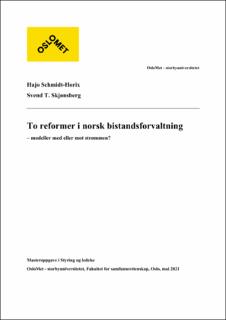| dc.description.abstract | In this thesis, we compare two organizational reforms within one policy area. How the "Modernization reform for development management" from 2002/03 and the "Reform for the organization of grant management" from 2018/19, affected the relationship between the Ministry of Foreign Affairs and Norad - the Norwegian Agency for Development Cooperation. Central is the political choice of the overall organizational model in the reforms, with two main alternatives: an integrated model in which the directorate becomes part of the ministry, and a delegated model that assigns the directorate additional tasks (enhanced vertical autonomy). In the thesis, we examine what led to the reform in 2003, and whether the newer reform can be regarded as a continuation of the 2003 reform.
We have chosen to base our analysis on the theoretical framework for reforms by Pollitt and Bouckaert. The thesis is a comparative case study, and the analysis is based on three types of data sources: semi-structured interviews, document analysis, and media coverage.
In the thesis, we find that several driving forces contributed to the initiation of reform in 2002/03, but that the Minister of Development's political ambitions must be regarded as a main reason to reform. The result of the reform was a mixed model, which can best be explained by the interaction - or tug-of-war - between two ministers, between foreign policy and development policy and the meeting between political desires and what was administratively feasible.
Unresolved issues in the 2003 reform led to constant attempts to find an administrative balance in the years between the two reforms. In 2019, driving forces within the political system, especially party politics, became decisive for the choice of model, after the political party KrF (the Christian Democrats) entered the government.
By studying the two reforms over time, we show in the thesis that ongoing discussions about the interface between politics and administration, as well as tensions between foreign policy and development policy interests, were central to the reform processes. This may help explain why reforms are repeated. The thesis is a contribution to understanding reforms in a context that also includes the time perspective. | en_US |
